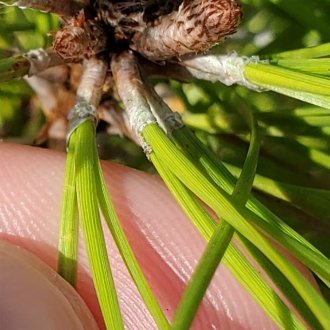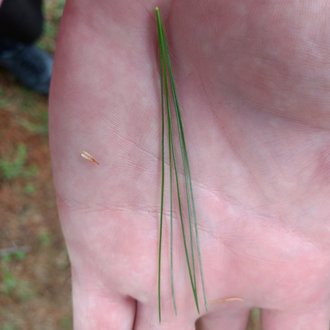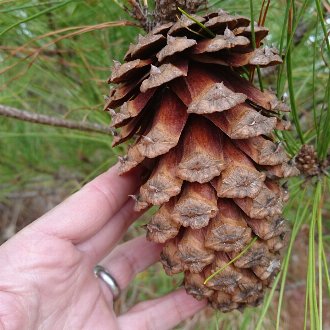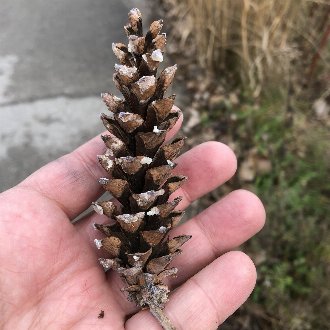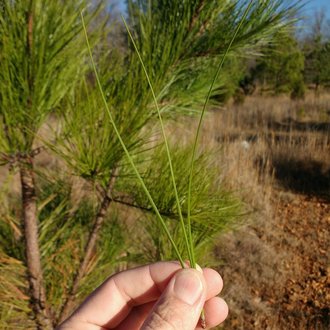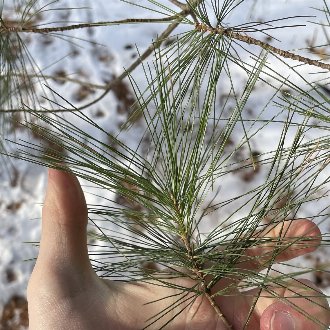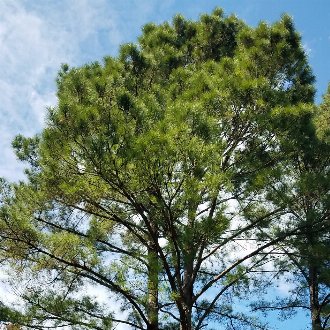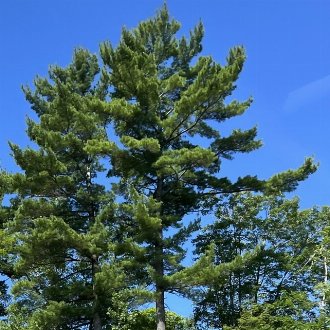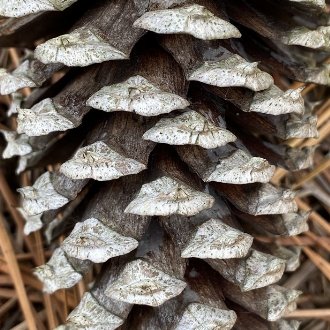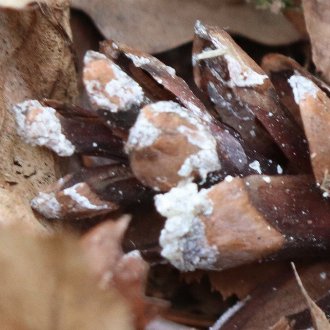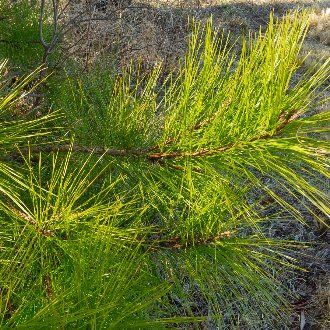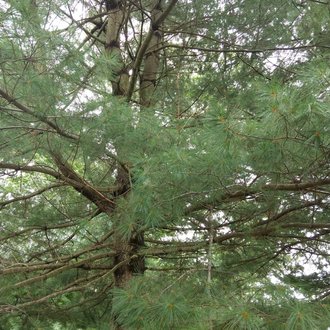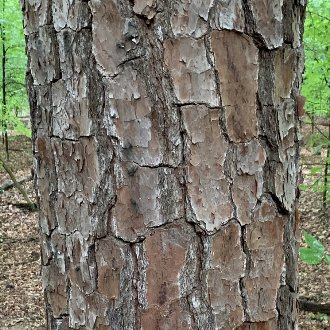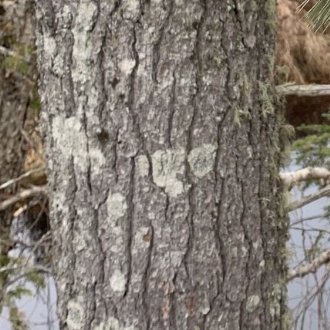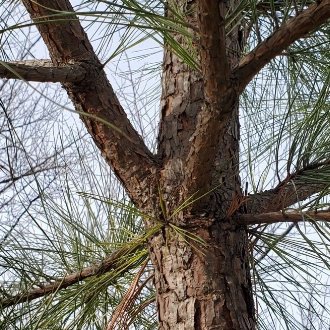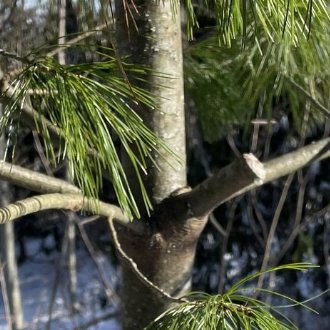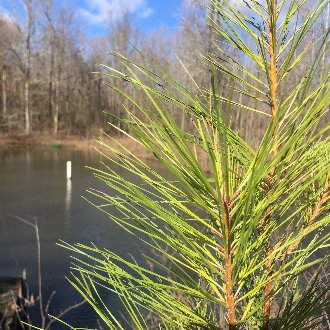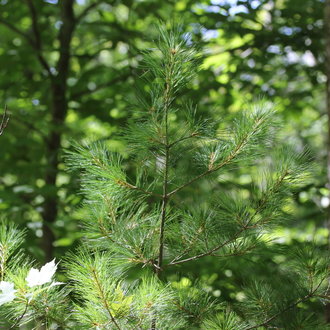Loblolly Pine vs Eastern White Pine
Both of these pines like richer, moister habitats than most pines. Although their range overlap is limited in the wild, both are widely planted in landscaping and forest plantations, and both have expanded their ranges near the area of overlap. They are easily distinguished by needles, bark, cones, and form. P. taeda ranges much farther south, requires more sun, is more tolerant of poor drainage, and is more likely in flat terrain. P. strobus is more shade-tolerant, more demanding of good drainage, and is more likely in sheltered ravines.
Loblolly Pine (Pinus taeda) | Eastern White Pine (Pinus strobus) |
A pine native to the southeastern US, favoring moist bottomlands, also widely planted in forestry. | A common native pine of the northeast, Eastern White Pine is the tallest tree in the east, and more shade-tolerant than most pines. |
Needles usually 3 to bundle. Rarely 2-4. Photo © Samuel A. Schmid, CC BY 4.0. | Needles 5 to a bundle. Photo © Mark Apgar, CC BY 4.0. |
Cones average shorter (6-12cm) and stouter. Photo © Abby Darrah, CC BY 4.0. | Cones average longer (8-20cm, rarely as short as 7cm) and narrower, with a more cylindric to lance-cylindric shape. Photo © Andrew Sebastian, CC BY 4.0. |
Needles are significantly longer (12-18cm, rarely 10-23cm) and thicker (1-2mm) with almost no overlap. Photo © Ken-ichi Ueda, CC BY 4.0. | Needles are significantly shorter (6-10cm) and narrower (0.7–1mm) with almost no overlap. Photo © jyoung2399, CC BY 4.0. |
Crown of mature trees averages more smoothly-rounded at top. Branches underneath the crown tend to leave the trunk at an upwards angle. Photo © lapemis, Public Domain. | Crown of mature trees tends to look more spiky or irregular. Branches underneath the crown tend to make a horizontal angle with the trunk, only curving upward towards their tips. Photo © Jacob Roetscher, CC BY 4.0. |
Cone scales do not have resinous tips. Older, dried-out cones have slightly lighter outer surfaces contrasting with darker inner surface, but no splotching. Photo © Zihao Wang, CC BY 4.0. | Cone scales have resinous tips, leading them to appear irregularly splotched with white against a darker background. Photo © Mark Apgar, CC BY 4.0. |
Foliage of healthy trees ranges from deep green to yellowish. Photo © John Ambler, Public Domain. | Foliage ranges from deep green to bluish-green. Foliage of healthy trees is never yellow. Photo © Mark Apgar, CC BY 4.0. |
Bark of mature trees is reddish-brown, with irregular rectangular plates broken by horizontal cracks. Photo © Jeff Clark, CC BY 4.0. | Bark of mature trees is gray and furrowed, with long, relatively unbroken ridges between long vertical cracks, and few horizontal features. Photo © Charlie Hohn, CC BY 4.0. |
Smaller branches and trunks have rough, orangeish to reddish bark. Photo © Alex Zorach, CC BY-SA 4.0. | Smaller branches and trunks have smooth gray bark, relatively featureless. Bark of young branches may occasionally be reddish, but is never rough. Photo © Kyle Van Houtan, CC BY 4.0. |
Seedlings and saplings are shade-intolerant and usually only found in full sun to nearly full sun. Can occur on poorly-drained sites. Photo © Joseph McPhail, Public Domain. | Seedlings and saplings are more shade-tolerant, can be found in shadier habitats, and in area of range overlap are more limited to cool, protected sites such as north-facing slopes. Photo © Even Dankowicz, CC BY 4.0. |
References & External Resources
These short lists show only links helpful for ID. For a complete list of references and resources also covering other aspects of ecology, visit the links section of the full article on each plant, which is the first entry here.



